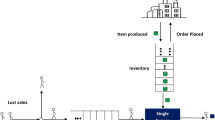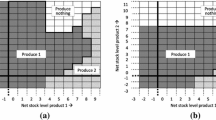Abstract
We consider a production-inventory control model with finite capacity and two different production rates, assuming that the cumulative process of customer demand is given by a compound Poisson process. It is possible at any time to switch over from the different production rates but it is mandatory to switch-off when the inventory process reaches the storage maximum capacity. We consider holding, production, shortage penalty and switching costs. This model was introduced by Doshi, Van Der Duyn Schouten and Talman in 1978. In their paper they found a formula for the long-run average expected cost per unit time as a function of two critical levels, in this paper we consider expected discounted cumulative costs instead. We seek to minimize this discounted cost over all admissible switching strategies. We show that the optimal cost functions for the different production rates satisfy the corresponding Hamilton-Jacobi-Bellman system of equations in a viscosity sense and prove a verification theorem. The way in which the optimal cost functions solve the different variational inequalities gives the switching regions of the optimal strategy, hence it is stationary in the sense that depends only on the current production rate and inventory level. We define the notion of finite band strategies and derive, using scale functions, the formulas for the different costs of the band strategies with one or two bands. We also show that there are examples where the switching strategy with two critical levels is not optimal.















Similar content being viewed by others
References
Avram F, Grahoavac D, Vardar-Acre C (2019) The W, Z scale functons kit for first passage problems of spectrally negative Lévy processes, and applications to control problems. https://www.esaim-ps.org/articles/ps/pdf/forth/ps170105.pdf
Azcue P, Muler N (2015) Optimal dividend payment and regime switching in a Compound Poisson risk model. SIAM J Control Optim 53(5):3270–3298
Barron Y, Perry D, Stadje W (2014) A jump-fluid production-inventory model with a double band control. Probab Eng Inf Sci 28:313–333
Barron Y, Perry D, Stadje W (2016) A make-to-stock production/inventory model with MAP arrivals and phase-type demands. Ann Oper Res 241:373–409
Bayraktar E, Egami M (2010) On the optimal switching problem for one dimensional-diffusions. Math Oper Res 35(1):140–159
Brekke K, Oksendal B (1994) Optimal switching in an economic activity under uncertainty, SIAM. J Cont Optim 32:1021–1036
Chang J, Lu H, Shi J (2019) Stockout risk of production-inventory systems with compound Poisson demands. Omega 83:181–198
Crandall MG, Lions PL (1983) Viscosity solution of Hamilton-Jacobi equations. Trans Amer Math Soc 277:1–42
De Kok AG, Tijms HC, Van Der Schouten FA (1984) Approximations for the single-product production-inventory problem with compound Poisson demand and service-level constraints. Adv Appl Probab 16(2):378–401
De Kok AG (1985) Approximations for a lost-sales production-inventory control model with service level constraints. Manage Sci 31(6):729–737
De Kok AG (1987) Approximations for operating characteristics in a production-inventory model with variable production rate. Eur J Oper Res 29:286–297
Doshi BT, Van Der Duyn Schouten FF, Talman AJJ (1978) A production-inventory control model with a mixture of backorders and lost sales. Manage Sci 24(10):1078–1086
Dufour Fr, Piunovskiy AB (2015) Impulsive control for continuous-time Markov decision processes. Adv Appl Probab 47:106–127
Fleming WH, Soner HM (2006) Controlled Markov Processes and Viscosity Solutions, 2nd edn. Springer
Fleming WH, Sethi SP, Soner HM (1987) An optimal stochastic production planning problem with randomly fluctuating demand. SIAM J Control Optim 25(6):1494–1502
Gavish B, Graves SC (1980) A one product production-inventory problem under continuous review policy. Oper Res 28(5):1222–1235
Graves SC, Keilson J (1981) The compensation method applied to one-product production-inventory problems. Math Oper Res 6(2):246–262
Guo X, Hernández-Lerma O (2009) Continuous-time Markov decision processes: theory and applications. Springer, Heidelberg
Hamadène S, Jeanblanc M (2007) On the Starting and Stopping Problem: Application in Reversible Investments. Math Oper Res 32(1):182–192
Kella O, Whitt W (1992) Useful martingales for stochastic storage processes with Lévy input. J Appl Probab 29:396–403
Kyprianou AE (2014) Fluctuations of Lévy Processes with Applications. Springer, Berlin Heidelberg
Loeffen R (2018) On obtaining simple identities for overshoots of spectrally negative Levy processes. arXiv:1410.5341
Pham H, Ly Vath V (2007) Explicit solution to an optimal switching problem in the two-regime case, SIAM. J Cont Optim 46:395–426
Pham H, Ly Vath V, Zhou XY (2009) Optimal Switching over Multiple Regimes. SIAM J Control Optim 48:2217–2253
Piunovskiy AB, Zhang Y (2014) Discounted continuous-time Markov decision processes with unbounded rates and randomized history-dependent policies: the dynamic programming approach. J Oper Res 12:49–75
Sethi SP, Zhang Q (1994) Hierarchical Decision Making in Stochastic Manufacturing Systems, Systems & Control: Foundations & Applications. Birkhäuser, Boston, Mass, USA
Shi J, Katehakis MH, Melamed B, Xia Y (2014) Production-inventory systems with lost sales and compound Poisson demands. Oper Res 62(5):1048–1063
Shi J (2016) Optimal continuous production-inventory systems subject to stockout risk. Ann Oper Res. https://doi.org/10.1007/s10479-016-2339-5
Varadhan SRS (2007) Stochastic Processes. Courant Lecture Notes 16, AMS
Author information
Authors and Affiliations
Corresponding author
Ethics declarations
Conflicts of Interest
No funds, grants, or other support was received. Prof. Esther Frostig is a member of the Editorial Board of MCAP and has no relevant financial interests to disclose. The other authors have no relevant financial or non-financial interests to disclose.
Additional information
Publisher's Note
Springer Nature remains neutral with regard to jurisdictional claims in published maps and institutional affiliations.
Appendix
Appendix
1.1 Proof of Proposition 3.2
We call \(S_{i}\) the positive upper bounds of the functions \(V_{i}\) for \(i=1,2.\) Given initial inventory level \(x\in [l,b)\) and initial phase \(i=1,2,\) take \(\delta \in (0,b-x]\) and consider an admissible strategy \(\pi _{x+\delta }\in \Pi _{x+\delta ,i}\) such that \(V_{i}^{\pi _{x+\delta }}(x+\delta )\le V_{i}(x+\delta )+\varepsilon ,\) where \(0<\varepsilon <\delta\). Let us now define the admissible strategy \(\pi _{x}\in \Pi _{x,i}\) as follows: stay in phase i until the controlled inventory level \(X_{t}^{\pi _{x}}\) reaches \(x+\delta\) and then follow \(\pi _{x+\delta }\in \Pi _{x+\delta ,i}\). Then, from (3.1) and Proposition 3.1, we get
Hence, we have
So, taking
we obtain
Let us prove now that there exists \(m_{i}^{2}>0\) such that,
We start showing that there exists m such that,
for all \(y\in [l,l+\delta ]\). Given \(\varepsilon >0\) and an initial inventory level l, consider the strategy \(\pi _{l}\in \Pi _{l,i}\) for \(i=1,2\) such that \(V_{i}^{\pi _{l}}(l)\le V_{i}(l)+\varepsilon\) and call \(X_{t}^{\pi _{l}}\) the associated process with initial inventory level l. Take also a strategy \(\pi _{b}\in \Pi _{b,0}\) such that \(V_{0}^{\pi _{b}}(b)\le V_{0}(b)+\varepsilon\).
Let us define the admissible strategy \(\pi _{y}\in \Pi _{y,i}\) for initial inventory level \(y\in [l,l+\delta ]\) as:
-
For \(0\le t\le T,\) follow \(\pi _{l}\) (and so the associated controlled processes \(X_{t}^{\pi _{y}}=X_{t}^{\pi _{l}}+(y-l)\) for \(t<T\)), where
$$\begin{aligned} T:=\min \{t:X_{t}^{\pi _{y}}=b\text { or }\overset{\vee }{X}_{t}^{\pi _{y}}-(y-l)=\overset{\vee }{X}_{t}^{\pi _{l}}<l\}. \end{aligned}$$ -
If \(X_{T}^{\pi _{y}}=b\), follow \(\pi _{b}\) for \(t\ge T\).
-
If \(\overset{\vee }{X}_{T}^{\pi _{y}}<l\) (and so \(X_{T}^{\pi _{y}}=X_{T}^{\pi _{l}}=l\)), follow \(\pi _{l}\) for \(t\ge T\).
-
If \(l\le X_{T}^{\pi _{y}}<y\) (and so \(X_{T}^{\pi _{l}}=l\) and \(X_{T}^{\pi _{y}}=\overset{\vee }{X}_{T}^{\pi _{y}}\)), also follow the strategy \(\pi _{l}\) for \(t\ge T\).
Given any stopping time \(\tau\), let us define \(\widehat{V}_{i}^{\pi _{y}}(y,\tau )\) as the expected discounted cost of the strategy before \(\tau\) and \(\widetilde{V}_{i}^{\pi _{y}}(y,\tau )\) as the expected discounted cost of the strategy after \(\tau\). Thus,
Let \(n_{D}\) be the sum of the numbers of discontinuities of \(h_{1}\) and \(h_{2}\). Note that between two customer demands, the inventory level \(X_{t}^{\pi _{y}}\) goes through at most \(n_{D}\) points of discontinuities of \(h_{\mathcal {J}_{t}}\). Hence, calling \(\tau _{0}=0\) and \(\overline{\lambda }=\max _{i=0,1,2}\lambda _{i}\), we have
Let us call \(\widetilde{T}:=\inf \left\{ t:X_{t}^{\pi _{l}}=b\right\}\) and \(\widetilde{\tau }\) the time of the first customer demand after T; we have that \(\mathbb {P}\left[ \widetilde{T}>\widetilde{\tau }\right] \le 1-e^{-\frac{\delta }{\sigma _{2}}\overline{\lambda }}\) and so
Let \(\Delta\) be the length of time after T in which the process \(X_{t}^{\pi _{l}}\) reaches b in the event of no arrivals of demands. In this case, we have
and so \(\frac{\delta }{\sigma _{1}}\le \Delta \le \frac{\delta }{\sigma _{2}}\). Hence, from (2.3),
Therefore,
Since the penalty functions \(p_{i}\) are non-decreasing, we also have,
Finally, since the event \(l\le X_{T}^{\pi _{y}}<y\) coincides with the arrival of a customer demand,
Hence, from (8.5), (8.6), (8.7) and (8.8), there exists \(\overline{m}\) large enough such that
So, we obtain (8.3) with \(m=\overline{m}\left( q+\lambda \right) /q\). The argument to show (8.2) is analogous.
1.2 Proof of Proposition 4.3
Consider \(\pi \in \Pi _{x,j}\). Let us extend \(\overline{u}_{1}\) and \(\overline{u}_{2}\) as \(\overline{u}_{i}(x)=\overline{u}_{i}(l)\) and \(\overline{u}_{0}(x)=\overline{u}_{0}(l)\) for \(x<l\). Consider the controlled risk process \(X_{t}^{\pi }\) starting at x and the function \(\mathcal {J}_{t}\) defined in (2.5). Since \(\overline{u}_{i}\) is Lipschitz for \(i=1,2\), we obtain that the function \(t\rightarrow e^{-qt}~\overline{u}_{\mathcal {J}_{t}}(X_{t}^{\pi })\) is absolutely continuous in between the stopping times \(\left\{ 0\right\} \cup \left\{ \tau _{n}:n\ge 1\right\} \cup \left\{ T_{k}:k\ge 1\right\}\). So, taking
we have
Let us define
with
it can be seen that \(M^{i}(z_{0},t_{0},t)\) is a martingale with zero expectation for \(t\ge t_{0}\).
Consider first the case \(J_{k}=i\) and \(J_{k+1}=j\) with \(i=1,2\), \(j=0,1,2\) and \(i\ne j\). Since \(\overline{u}_{i}\) is absolutely continuous, the function \(t\rightarrow \overline{u}_{i}(X_{t}^{\pi })e^{-qt}\) is also absolutely continuous, between customer demands. Using an extension of the Dynkin’s Formula, we obtain
and so, since \(\overline{u}_{i}\) is a supersolution of (4.5), we get that
In the case \(J_{k}=0\) we have \(\mathcal {J}_{T_{k+1}}\ne 0\), then \(X_{s}^{\pi }=b\) in \([T_{k},T_{k+1})\) , \(T_{k+1}=\tau _{n}^{0}\) for some n and so, analogously to the previous case,
and, since \(T_{k+1}-T_{k}\) is distributed as \(exp(\lambda _{0})\), we obtain that
and so
Analogously, we can prove that
Taking the expected value in (8.9), we obtain
taking the limit with t going to infinity, and using that \(X_{t}^{\pi }\in [l,b]\) we obtain that \({\overline{u}}_{j}(x)\le {V}_{j}^{\pi}(x)\) for \(j=1,2\).
Considering instead the controlled risk process \(X_{t}^{\pi }\) starting at b, we obtain with a similar proof that \(\overline{u}_{0}(b)\le V_{0}^{\pi }(b)\).
Rights and permissions
Springer Nature or its licensor (e.g. a society or other partner) holds exclusive rights to this article under a publishing agreement with the author(s) or other rightsholder(s); author self-archiving of the accepted manuscript version of this article is solely governed by the terms of such publishing agreement and applicable law.
About this article
Cite this article
Azcue, P., Frostig, E. & Muler, N. Optimal Strategies in a Production Inventory Control Model. Methodol Comput Appl Probab 25, 43 (2023). https://doi.org/10.1007/s11009-023-10024-3
Received:
Revised:
Accepted:
Published:
DOI: https://doi.org/10.1007/s11009-023-10024-3
Keywords
- Inventory/Production model
- Optimal switching strategies
- Compound Poisson process
- Scale functions
- Hamilton-Jacobi-Bellman equations
- Viscosity solutions




